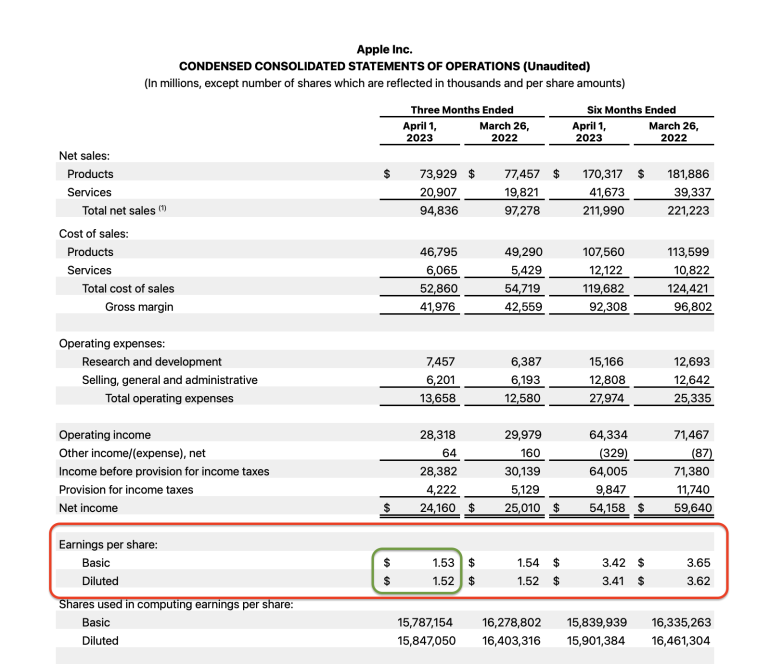What Is EPS? An Introduction to Earnings Per Share

Many or all of the products featured here are from our partners who compensate us. This influences which products we write about and where and how the product appears on a page. However, this does not influence our evaluations. Our opinions are our own. Here is a list of our partners and here's how we make money.
The investing information provided on this page is for educational purposes only. NerdWallet, Inc. does not offer advisory or brokerage services, nor does it recommend or advise investors to buy or sell particular stocks, securities or other investments.
Earnings per share (EPS) is more or less what it sounds like — a measurement of a publicly traded company’s profits on a per-share basis.
The legendary value investor Warren Buffett once said that “the value of an asset, whatever its character, cannot over the long term grow faster than its earnings do.”
Earnings per share is also important to dividend investors, growth investors and speculators. Here’s how to calculate it, and how to use it to analyze stocks.
NerdWallet rating 4.9 /5 | NerdWallet rating 5.0 /5 | NerdWallet rating 4.1 /5 |
Fees $0 per online equity trade | Fees $0 per trade | Fees $0 per trade |
Account minimum $0 | Account minimum $0 | Account minimum $0 |
Promotion None no promotion available at this time | Promotion None no promotion available at this time | Promotion Get up to $700 when you open and fund a J.P. Morgan Self-Directed Investing account with qualifying new money. |
EPS formula and example
A company’s EPS is equal to its net income — sometimes called net earnings, net profit, or net interest income in the case of banks — divided by its average number of shares outstanding over a given time period, such as a quarter or a year.
When net earnings is negative, it’s called net loss, and EPS is called loss per share. A company with positive annual EPS is considered profitable, while a company with negative annual EPS is considered unprofitable.
As an example, let’s look at one of the largest companies in the S&P 500 index. On May 4, 2023, Apple reported its second-quarter 2023 results. The company earned $24.16 billion in net income, and had an average of 15.79 billion outstanding shares over the quarter. That means its basic EPS for the quarter was $1.53.
How to read an earnings report
A publicly traded company discloses its EPS four times a year in quarterly earnings reports. After the last quarter of its fiscal year — which may or may not be the same as the calendar year — it releases an annual report that shows its earnings over the year.
These reports typically take the form of press releases, PDFs or posts on a company’s website. They typically start with comments from the CEO or other major officers that may put a positive spin on the company’s recent performance.
You often have to scroll down quite a ways through an earnings report to get to the table that contains the actual earnings numbers — in Apple’s case, it was in a PDF attached to the earnings report page on the Apple website. Once you find the table, you often have to dig a little more to find EPS.
Below is a screenshot of the earnings table from Apple’s Q2 2023 report. The big red rectangle shows the rows containing EPS numbers, while the smaller green rectangle shows the EPS numbers themselves.

If you don’t need to see a company’s EPS right at the moment it’s released, you can also check a financial data website, such as Yahoo Finance, which typically updates its EPS data by the end of the day of a company’s most recent earnings report.
Basic EPS vs. diluted EPS vs. adjusted EPS
You may notice that there are two different EPS numbers in the table above: basic and diluted. Some companies also report “adjusted” EPS. These three kinds of EPS numbers are all useful for different kinds of analysis.
Basic EPS
Basic EPS, as the name implies, is the simpler way of calculating EPS, and only uses outstanding shares of common stock in the calculation.
Diluted EPS
Diluted EPS also accounts for other kinds of securities that can be converted into common shares, such as employee stock options and convertible bonds.
Diluted EPS is calculated using a larger number of shares than basic EPS. It’s lower because it has a larger denominator.
Adjusted EPS
In some cases, companies may also provide an adjusted EPS number, which is usually diluted EPS with atypical one-time items removed.
For example, when the Tax Cuts and Jobs Act of 2017 was passed, some big banks were sitting on large tax credits saved up from previous years — and saw the value of these tax credits suddenly decrease because of the lowering of the corporate tax rate.
That decrease in value didn’t have anything to do with the banks’ operations, but it still had to be accounted for in their official EPS calculations. Some banks, such as Morgan Stanley, provided adjusted EPS numbers that removed the effects of the tax change in their 2017 reports.
When to use basic, diluted or adjusted EPS
Which EPS numbers should you pay attention to? That depends on what you’re doing. If you’re comparing one company with another, you’ll want to use diluted EPS if both companies report it.
But not all companies report diluted EPS, because not all companies issue dilutive securities such as employee stock options or convertible bonds. In those cases, you’ll want to use basic EPS for company-to-company comparisons. Basic and diluted EPS calculations are both standardized across companies by the Generally Accepted Accounting Principles (GAAP).
Adjusted EPS is a non-GAAP number, but it may be more useful for comparing a company to itself — for example, to calculate its EPS growth rate over time — because it excludes one-time items and can give a clearer picture of the company’s operations.
What is EPS used for?
EPS has a variety of uses to different investors. Value investors use it to calculate PE ratio, growth investors use it to calculate EPS growth, and dividend investors use it to calculate dividend payout ratio.
PE ratio
PE ratio is equal to a company’s share price divided by its EPS over the last 12 months. It’s a way of evaluating the price of a company in terms of its earnings.
If a company’s shares are worth $10 and its EPS over the last year is $0.50, then it has a PE ratio of 20, or “trades for 20 times earnings.”
EPS growth
EPS growth is pretty self-explanatory; it’s a way of measuring how fast a company is growing in terms of its earnings.
Quarterly year-over-year EPS growth is a company’s most recent quarterly EPS divided by its EPS from the same quarter the prior year, minus 1. Annual EPS growth is a company’s EPS over the last year divided by its EPS over the prior year, minus 1.
If a company’s most recent quarterly EPS is $0.12, and its EPS in the same quarter last year was $0.09, then it has a quarterly year-over-year EPS growth rate of 33%.
Dividend payout ratio
Dividend payout ratio is equal to a company’s dividends per share divided by its EPS for a given quarter or year.
Dividends are a return of profits (in other words, EPS) to shareholders, so dividend payout ratio is a way of assessing the financial sustainability of a dividend. A payout ratio under 100% indicates an affordable dividend, while a payout ratio over 100% indicates that a company may need to dip into its cash reserves or borrow money to afford its dividend.
If a company has paid out $0.40 per share in dividends over the last year and has EPS of $0.50 over the last year, it has a dividend payout ratio of 80%.
If a company pays out $0.60 per share in dividends over the course of a year and has EPS of $0.40, it has a dividend payout ratio of 150% and will not be able to afford its dividend indefinitely.
EPS estimates and surprises
When a large company is due to report earnings, stock analysts try to guess what its EPS and revenue will be ahead of time. The analyst guesses from all the major investment banks are averaged together to create a “consensus estimate” for the company’s EPS and revenue.
When the company finally releases its earnings report, some day traders will buy or sell it based on whether its actual EPS beat the consensus estimate, or missed it. Others may use call options, put options or short selling to make even bigger positive or negative bets on the stock's post-earnings performance. (If you're not familiar with those terms, you can also check out our guide to options trading for beginners.)
The percentage difference between the actual EPS and the consensus estimate is called the “surprise.” Positive surprises — or “beats,” in trader lingo — can cause a company’s share price to surge, while negative surprises — or “misses” — can cause it to crash.
For example, on May 31, 2023, online pet supply vendor Chewy reported EPS of $0.05 per share for Q1 2023, when the consensus estimate was -$0.04 per share. The day trading world responded enthusiastically to this major beat, and the stock closed more than 21% higher the next day.

What is a good EPS?
The answer to “what is a good EPS” for a particular stock depends on what you’re trying to do — and on the industry that stock operates in. Dividend investors generally like stocks with low payout ratios, value investors are often looking for stocks with lower PE ratios than their peers, and growth investors typically want to see EPS rising over time.
PE ratio below industry average
In a value investing context, companies that have lower PE ratios than similar companies in their industry are considered undervalued stocks.
Imagine a fictional shoe company called XYZ Shoe Company. If most shoe companies have PE ratios around 20, and XYZ Shoe Company has a PE ratio of 15, then XYZ is 25% less expensive than its peers on an earnings basis.
A value investor might buy XYZ stock out of a belief that it is trading at a discount to its fair value, as demonstrated by the higher PE ratios of similar shoe companies.
But an unusually low PE ratio isn’t always a good sign. It can also indicate that investors expect a company’s earnings to fall in the future due to some bad news that isn’t expressed in EPS — such as, for example, a rival company launching a better product at a lower price. It’s important to supplement PE ratio analysis with other methods of researching stocks.
Rising EPS that beats analyst estimates
Growth investors typically compare a company’s current EPS to its EPS in the same quarter last year. They might look for a growth stock whose year-over-year EPS growth is higher than others in its industry, or a company whose EPS is growing faster than its share price.
Short-term growth investors and speculators are particularly interested in companies whose EPS they think will beat analyst estimates, as an earnings beat can fuel a short-term rally in a stock’s price.
However, there’s no foolproof way to identify a company whose EPS is likely to beat estimates.
Betting on an earnings beat basically means you think you know something that the best Wall Street analysts don’t know. That’s not impossible — but it’s a risky idea to bet money on.
Dividend payout ratio below 80%
A common rule of thumb for dividend investing is to look for dividend stocks with payout ratios below 80% — stocks where dividends per share account for no more than 80% of EPS. A higher payout ratio is often a sign that a dividend is unsustainably high, as the company would have to go into debt or cut its dividend in the event of a small downturn in earnings.
There are exceptions to the 80% guideline, however. Real estate investment trusts (REITs), which are also popular among dividend investors, are required by law to pay out at least 90% of their taxable income as dividends. They get special tax breaks that help make higher payout ratios more sustainable.
Neither the author nor editor held positions in the aforementioned investments at the time of publication.
On a similar note...






